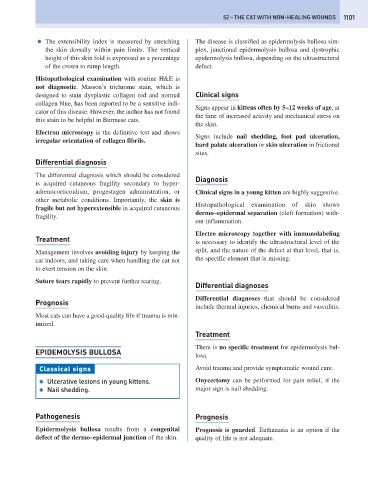Page 1109 - Problem-Based Feline Medicine
P. 1109
52 – THE CAT WITH NON-HEALING WOUNDS 1101
● The extensibility index is measured by stretching The disease is classified as epidermolysis bullosa sim-
the skin dorsally within pain limits. The vertical plex, junctional epidermolysis bullosa and dystrophic
height of this skin fold is expressed as a percentage epidermolysis bullosa, depending on the ultrastructural
of the crown to rump length. defect.
Histopathological examination with routine H&E is
not diagnostic. Masson’s trichrome stain, which is
designed to stain dysplastic collagen red and normal Clinical signs
collagen blue, has been reported to be a sensitive indi-
Signs appear in kittens often by 5–12 weeks of age, at
cator of this disease. However, the author has not found
the time of increased activity and mechanical stress on
this stain to be helpful in Burmese cats.
the skin.
Electron microscopy is the definitive test and shows
Signs include nail shedding, foot pad ulceration,
irregular orientation of collagen fibrils.
hard palate ulceration or skin ulceration in frictional
sites.
Differential diagnosis
The differential diagnosis which should be considered
Diagnosis
is acquired cutaneous fragility secondary to hyper-
adrenocorticoidism, progestagen administration, or Clinical signs in a young kitten are highly suggestive.
other metabolic conditions. Importantly, the skin is
Histopathological examination of skin shows
fragile but not hyperextensible in acquired cutaneous
dermo–epidermal separation (cleft formation) with-
fragility.
out inflammation.
Electro microscopy together with immunolabeling
Treatment is necessary to identify the ultrastructural level of the
Management involves avoiding injury by keeping the split, and the nature of the defect at that level, that is,
cat indoors, and taking care when handling the cat not the specific element that is missing.
to exert tension on the skin.
Suture tears rapidly to prevent further tearing.
Differential diagnoses
Differential diagnoses that should be considered
Prognosis
include thermal injuries, chemical burns and vasculitis.
Most cats can have a good-quality life if trauma is min-
imized.
Treatment
There is no specific treatment for epidermolysis bul-
EPIDEMOLYSIS BULLOSA
losa.
Classical signs Avoid trauma and provide symptomatic wound care.
● Ulcerative lesions in young kittens. Onycectomy can be performed for pain relief, if the
● Nail shedding. major sign is nail shedding.
Pathogenesis Prognosis
Epidermolysis bullosa results from a congenital Prognosis is guarded. Euthanasia is an option if the
defect of the dermo–epidermal junction of the skin. quality of life is not adequate.

